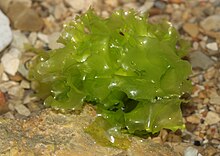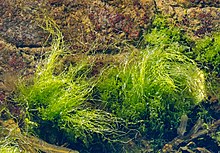Sea lettuce
| Sea lettuce | |
|---|---|

| |
| Ulva lactuca | |
| Scientific classification | |
| (unranked): | Viridiplantae |
| Division: | Chlorophyta |
| Class: | Ulvophyceae |
| Order: | Ulvales |
| Family: | Ulvaceae |
| Genus: | Ulva Linnaeus,1753 |
| Species | |
|
See text | |
| Synonyms[1] | |
| |

Thesea lettucescomprise thegenusUlva,a group of ediblegreen algaethat is widely distributed along the coasts of the world'soceans.The type species within the genusUlvaisUlva lactuca,lactucabeingLatinfor "lettuce". The genus also includes the species previously classified under the genusEnteromorpha,[1]the former members of which are known under the common namegreen nori.[2]
Description
[edit]Individual blades ofUlvacan grow to be more than 400 mm (16 in) in size, but this occurs only when the plants are growing in sheltered areas. A macroscopic alga which is light to dark green in colour, it is attached by disc holdfast. Their structure is a leaflike flattenedthallus.[3][4]
Nutrition and contamination
[edit]Sea lettuce is eaten by a number of different sea animals, includingmanateesand the sea slugs known assea hares.Many species of sea lettuce are a food source for humans inScandinavia,Great Britain,Ireland,China,andJapan(where this food is known asaosa). Sea lettuce as a food for humans is eaten raw insaladsand cooked insoups.It is high inprotein,solubledietary fiber,and a variety ofvitaminsandminerals,especiallyiron.[5]However, contamination withtoxic heavy metalsat certain sites where it can be collected makes it dangerous for human consumption.[5]
Aquarium trade
[edit]Sea lettuce species are commonly found in the saltwater aquarium trade, where the plants are valued for their high nutrient uptake and edibility. Many reef aquarium keepers use sea lettuce species inrefugiaor grow it as a food source for herbivorous fish. Sea lettuce is very easy to keep, tolerating a wide range of lighting and temperature conditions. In the refugium, sea lettuce can be attached to live rock or another surface, or simply left to drift in the water.
Health concerns
[edit]In August 2009, unprecedented amounts of these algae washed up on the beaches ofBrittany,France,causing a major public health scare as it decomposed. The rotting leaves produced large quantities ofhydrogen sulfide,a toxic gas. In one incident nearSaint-Michel-en-Grève,a horse rider lost consciousness and his horse died after breathing the seaweed fumes; in another, a lorry driver driving a load of decomposing sea lettuce passed out, crashed, and died, with toxic fumes claimed to be the cause.[6]Environmentalists blamed the phenomenon on excessive nitrogenous compounds washed out to sea from improper disposal of pig and poultry animal waste from industrial farms.
Species
[edit]Species in the genusUlvainclude:[7]
- Accepted species
- Ulva acanthophora(Kützing) Hayden, Blomster,Maggs,P.C. Silva,Stanhope & J.R. Waaland, 2003
- Ulva anandiiAmjad &Shameel,1993
- Ulva arasakiiChihara, 1969
- Ulva atroviridisLevring, 1938
- Ulva australisAreschoug, 1854
- Ulva beytensisThivy & Sharma, 1966
- Ulva bifronsArdré, 1967
- Ulva brevistipitaV.J. Chapman, 1956
- Ulva burmanica(Zeller) De Toni, 1889
- Ulva californicaWille, 1899
- Ulva chaetomorphoides(Børgesen) Hayden, Blomster, Maggs, P.C. Silva, M.J. Stanhope & J.R. Waaland, 2003
- Ulva clathrata(Roth) C. Agardh, 1811
- Ulva compressaLinnaeus, 1753
- Ulva conglobataKjellman, 1897
- Ulva cornutaLightfoot, 1777
- Ulva covelongensisV. Krishnamurthy & H. Joshi, 1969
- Ulva crassaV.J. Chapman, 1956
- Ulva crassimembrana(V.J. Chapman) Hayden, Blomster, Maggs, P.C. Silva, M.J. Stanhope & J.R. Waaland, 2003
- Ulva curvata(Kützing) De Toni, 1889
- Ulva denticulataP.J.L. Dangeard, 1959
- Ulva diaphanaHudson, 1778
- Ulva elegansGayral, 1960
- Ulva enteromorphaLe Jolis, 1863
- Ulva erecta(Lyngbye) Fries
- Ulva expansa(Setchell) Setchell & N.L. Gardner, 1920
- Ulva fasciataDelile, 1813
- Ulva flexuosaWulfen, 1803
- Ulva geminoideaV.J. Chapman, 1956
- Ulva gigantea(Kützing) Bliding, 1969
- Ulva grandisSaifullah & Nizamuddin, 1977
- Ulva hookeriana(Kützing) Hayden, Blomster, Maggs, P.C. Silva, M.J. Stanhope & J.R. Waaland
- Ulva hopkirkii(M'Calla ex Harvey) P. Crouan & H. Crouan
- Ulva howensis(A.H.S. Lucas) Kraft, 2007
- Ulva indicaRoth, 1806
- Ulva intestinalisLinnaeus,1753
- Ulva intestinaloides(R.P.T. Koeman & Hoek) Hayden, Blomster, Maggs, P.C. Silva, M.J. Stanhope & J.R. Waaland, 2003
- Ulva javanicaN.L. Burman, 1768
- Ulva kylinii(Bliding) Hayden, Blomster, Maggs, P.C. Silva, M.J. Stanhope & J.R. Waaland, 2003
- Ulva lactucaLinnaeus,1753
- Ulva laetevirensJ.E. Areschoug, 1854
- Ulva laingiiV.J. Chapman, 1956
- Ulva linearisP.J.L. Dangeard, 1957
- Ulva linzaLinnaeus,1753
- Ulva lippiiLamouroux
- Ulva litoralisSuhr ex Kützing
- Ulva littoreaSuhr
- Ulva lobata(Kützing) Harvey, 1855
- Ulva marginata(J. Agardh) Le Jolis
- Ulva micrococca(Kützing) Gobi
- Ulva mutabilisFöyn, 1958
- Ulva neapolitanaBliding, 1960
- Ulva nematoideaBory de Saint-Vincent, 1828
- Ulva ohnoiHiraoka & Shimada, 2004
- Ulva olivascensP.J.L. Dangeard
- Ulva pacificaEndlicher
- Ulva papenfussiiPham-Hoang Hô, 1969
- Ulva parvaV.J. Chapman, 1956
- Ulva paschimaBast
- Ulva patengensisSalam & Khan, 1981
- Ulva percursa(C. Agardh) C. Agardh
- Ulva pertusaKjellman, 1897
- Ulva phyllosa(V.J. Chapman) Papenfuss
- Ulva polycladaKraft, 2007
- Ulva popenguinensisP.J.L. Dangeard, 1958
- Ulva porrifolia(S.G. Gmelin) J.F. Gmelin
- Ulva profundaW.R. Taylor, 1928
- Ulva proliferaO.F.Müller, 1778
- Ulva pseudocurvataKoeman & Hoek, 1981
- Ulva pseudolinza(R.P.T. Koeman & Hoek) Hayden, Blomster, Maggs, P.C. Silva, M.J. Stanhope & J.R. Waaland, 2003
- Ulva pulchraJaasund, 1976
- Ulva quilonensisSindhu & Panikkar, 1995
- Ulva radiata(J. Agardh) Hayden, Blomster, Maggs, P.C. Silva, M.J. Stanhope & J.R. Waaland, 2003
- Ulva ralfsii(Harvey) Le Jolis, 1863
- Ulva ranunculataKraft & A.J.K. Millar, 2000
- Ulva reticulataForsskål, 1775
- Ulva rhacodes(Holmes) Papenfuss, 1960
- Ulva rigidaC. Agardh, 1823
- Ulva rotundataBliding, 1968
- Ulva saifullahiiAmjad & Shameel, 1993
- Ulva serrataA.P.de Candolle
- Ulva simplex(K.L. Vinogradova) Hayden, Blomster, Maggs, P.C. Silva, M.J. Stanhope & J.R. Waaland, 2003
- Ulva sorenseniiV.J. Chapman, 1956
- Ulva spinulosaOkamura & Segawa, 1936
- Ulva stenophyllaSetchell & N.L. Gardner, 1920
- Ulva sublittoralisSegawa, 1938
- Ulva subulata(Wulfen) Naccari
- Ulva taeniata(Setchell) Setchell & N.L. Gardner, 1920
- Ulva tanneriH.S. Hayden & J.R. Waaland, 2003
- Ulva teneraKornmann & Sahling
- Ulva torta(Mertens) Trevisan, 1841
- Ulva tuberosaPalisot de Beauvois
- Ulva uncialis(Kützing) Montagne, 1850
- Ulva uncinataMohr
- Ulva uncinataMertens
- Ulva usneoidesBonnemaison
- Ulva utricularis(Roth) C. Agardh
- Ulva utriculosaC. Agardh
- Ulva uvoides Boryde Saint-Vincent
- Ulva ventricosaA.P.de Candolle
- Ulva costataWollny, 1881
- Ulva repensClemente, 1807
- Ulva tetragonaA.P.de Candolle, 1807
A newly discovered Indian endemic species ofUlvawith tubular thallus indistinguishable fromUlva intestinalishas been formally established in 2014 asUlva paschimaBast.[8] Ten new species have been discovered in New Caledonia:Ulva arbuscula,Ulva planiramosa,Ulva batuffolosa,Ulva tentaculosa,Ulva finissima,Ulva pluriramosa,Ulva scolopendraandUlva spumosa.[9]
See also
[edit]References
[edit]- ^abHillary S. Hayden; Jaanika Blomster;Christine A. Maggs;Paul C. Silva; Michael J. Stanhope & J. Robert Waaland (2003)."Linnaeus was right all along:UlvaandEnteromorphaare not distinct genera "(PDF).European Journal of Phycology.38(3): 277–294.CiteSeerX10.1.1.330.5106.doi:10.1080/1364253031000136321.ISSN1469-4433.S2CID18856367.Archived fromthe original(PDF)on 2011-08-07.
- ^M.D. Guiry & G.M. Guiry (2012)."EnteromorphaLink in Nees, 1820 ".AlgaeBase.National University of Ireland.RetrievedFebruary 11,2012.
- ^"Sea lettuce | green algae".Encyclopedia Britannica.Retrieved2021-02-23.
- ^Burrows, E.M. 1991.Seaweeds of the British Isles. Volume 2 Chlorophyta.Natural History Museum,ISBN0-565-00981-8
- ^abYaich, H.; Garna, H.; Besbes, S.; Paquot, M.; Blecker, C.; Attia, H. (2011), "Chemical composition and functional properties ofUlva lactucaseaweed collected in Tunisia ",Food Chemistry,128(4): 895–901,doi:10.1016/j.foodchem.2011.03.114,S2CID85407130
- ^"Seaweed suspected in French death".BBC.September 7, 2009.RetrievedSeptember 7,2009.
- ^M.D. Guiry (2012). Guiry MD, Guiry GM (eds.)."UlvaLinnaeus, 1753 ".AlgaeBase.National University of Ireland, Galway.World Register of Marine Species.RetrievedFebruary 11,2012.
- ^BAST, F., JOHN, A.A. AND BHUSHAN, S. 2014. Strong endemism of bloom-forming tubularUlvain Indian west coast, with description ofUlva paschimaSp. Nov. (Ulvales, Chlorophyta.PLoS ONE 9(10): e109295.doi:10.1371/journal.pone.0109295
- ^Lagourgue, Let al2022 The new species ofUlva(Ulvophyceae, Chlorophyta) discovered in New Caledonia genetic and morphological and diversity, and bloom potential.British Phycological Society57;458 - 478.
External links
[edit]- Marine botany: Ulva
- C. Tanner & Robert Wilkes (2005-02-17)."UlvaLinnaeus 1753: 1163 ".AlgaeBase.
- Toxic seaweed clogs French coast Caledonia: morphological diversity, and bloom potential.t (BBC)
Other References
[edit]Beer,Sven. 2023 Photosynthetic traits of ubiquitous and prolific macroalgaUlva(Chlorophyta): a review.European Journal of Phycology58:390 - 398.
